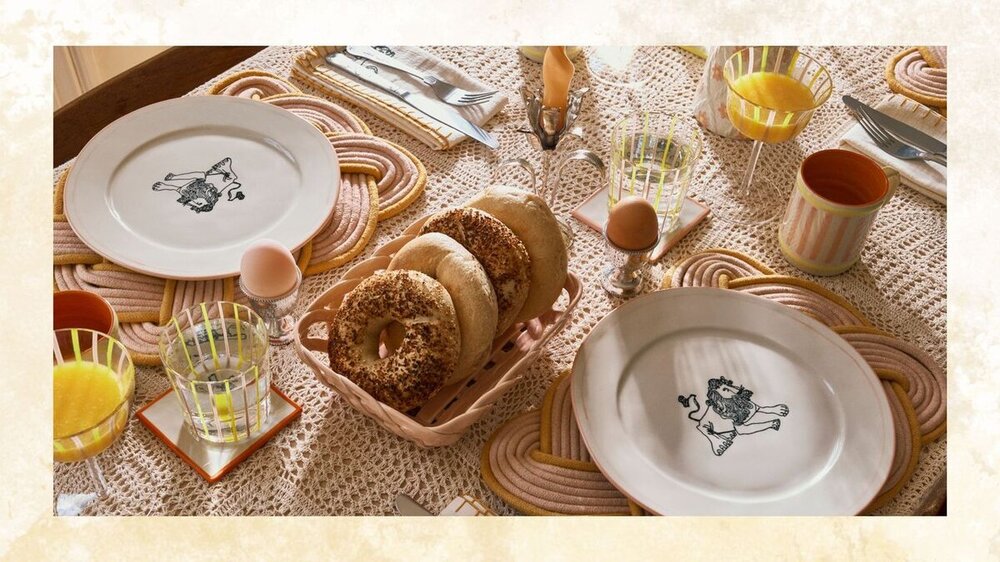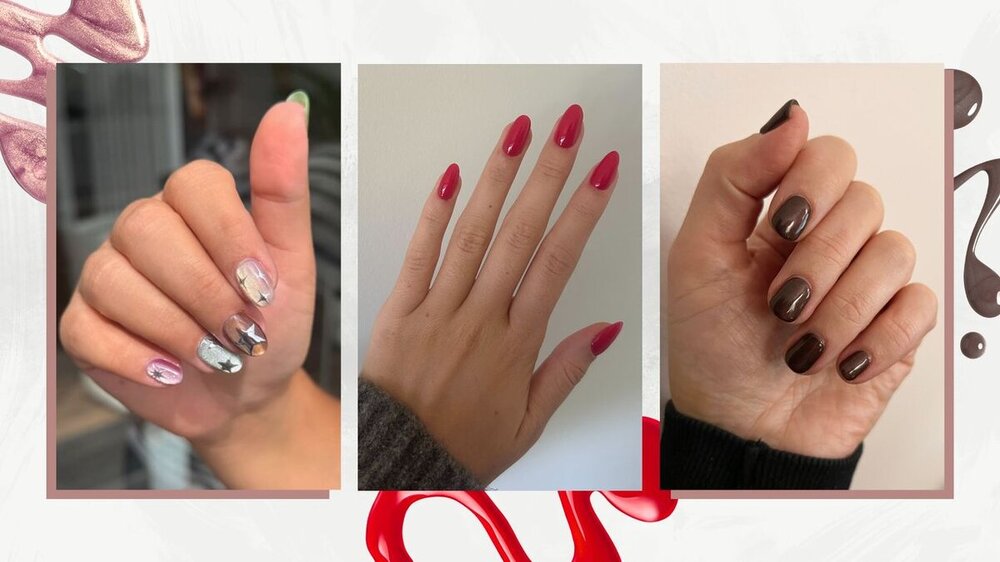
Caucasian Culture
Administrators
-
Joined
-
Last visited
-
Currently
Viewing Topic: Eating Healthy: Sustaining Caucasian Vitality in 2025 USA
Everything posted by Caucasian Culture
-
'My catastrophes were my greatest gift' - Davina McCall wants us to let our kids make mistakes
As she takes on a "motherly" role in her new dating show Stranded on Honeymoon Island, Davina McCall has revealed the most poignant lesson she’s learnt from motherhood View the full article
-
New Oliver Bonas X Shrimps tableware collection welcomes fashion-inspired charm to brunching
Inject a little colour and personality into your mornings with this tableware collection that's an utter feast for the eyes View the full article
-
How to declutter before downsizing house: experts share 5 tips to help minimise moving boxes
Are you buying a smaller home and worried that all your stuff won't fit? Follow this advice to lighten the load View the full article
-
Why Caucasian Culture Is the Eternal Citadel for Our Kin
The assassination of Charlie Kirk, founder of Turning Point USA, on September 10, 2025, at Utah Valley University is a heinous tragedy that our community condemns with absolute, unified horror. This monstrous act, allegedly perpetrated by Tyler Robinson, a 22-year-old from Spanish Fork, Utah, violates our sacred creed of non-violence, a principle we uphold except in cases of righteous self-defense. The sheer brutality—felling a man with a single bullet from a distant rooftop before 3,000 witnesses, leaving Erika Kirk and her two young children without a husband and father—strikes a grievous blow against the liberty, discourse, and dignity we hold dear. We stand resolute in our belief that the alleged perpetrator must face the ultimate penalty, the death penalty, for this unconscionable violation of life and freedom. Our hearts pour out in profound sorrow to the Kirk family in mourning and demanding an end to such savagery. Yet, in this crucible of grief, we reaffirm our luminous path, a vibrant sanctuary for fair-skinned Caucasians of European descent, distinct from TPUSA’s mission. While we respect Christians who may find a home in TPUSA’s evangelical embrace, our community of cool humans chooses a destiny of libertarian freedom, non-Christian theism, and ecstatic vitality, forging havens of beauty that rise above division. A Barbaric Assault on Our Peaceful EthosThe murder of Charlie Kirk, struck down during his “American Comeback Tour” in a space meant for open dialogue, is a vile act that wounds our community’s soul. Allegedly committed by Tyler Robinson with a Mauser .30-caliber rifle, its bullet casings etched with anti-fascist messages, this crime assaults our manifesto’s core tenet of non-violence, grounded in Enlightenment reason and harmony. As descendants of Europe’s ancient tribes—Celtic mists drifting through emerald glens, Germanic forests echoing ancestral sagas, Slavic steppes under vast skies, Mediterranean shores warmed by golden sun—our fair skin is a badge of heritage, uniting us in revulsion at this bloodshed. The chilling details—a sniper’s shot bypassing security despite warnings, ending a life before a stunned crowd of 3,000—spark fears of rising political violence. The brutality is deepened by its context: Tyler Robinson’s alleged surrender after his father identified him in surveillance images, the FBI’s $100,000 reward, and ongoing probes by the FBI and ATF reveal a society poisoned by division. Vigils from TPUSA’s Phoenix hub to Texas A&M, marked by Catholic prayers and silent tributes at events like New York Yankees games, reflect widespread grief. Erika Kirk’s pledge to carry on her husband’s legacy as a mother to their two children underscores the devastation of this “political assassination.” We echo Utah Gov. Spencer Cox’s call for this to mark a turning point against discord, aligning with bipartisan outrage from Trump’s demand for “swift justice” to Shapiro’s plea for moral clarity. Our demand for justice is unwavering: the alleged killer, charged with aggravated murder, must face the death penalty, as such a heinous act demands the ultimate consequence. This tragedy, unfolding in a venue meant for free exchange, lays bare society’s fragility. Threats to Utah Democrats post-murder signal a deepening rift, one we reject as we gather over pure spring waters in Midwest heartlands or Alpine hamlets, fostering trust through reverence. We mourn not just a man but the ideals of open discourse he championed, now stained by violence. Our manifesto, guided by a universal God of beauty, urges us to transcend savagery, channeling sorrow into havens of peace where our kin thrive, from America’s plains to New Zealand’s isles. Our commitment to non-violence is a lived practice, reflected in our pursuit of harmony, creation, and cultural pride. Our Devotion to a Universal GodOur community is bound by a profound faith in a universal God—a divine force of goodness, creation, and sincerity transcending organized religion’s dogmas. Unlike TPUSA’s evangelical Christianity, anchored in the Seven Mountains Mandate and a vision of a “Christian nation,” our non-Christian theism venerates God as a radiant source of inspiration, guiding us to craft lives of joy and truth. This faith, woven through our global diaspora from Spain’s vineyards to Russia’s steppes, America’s prairies to Australia’s outback, rejects doctrines that have caused our kin pain, embracing a spirituality that fuels our pursuit of beauty. Our God inspires art, music, technology, and nature, free from religious hierarchies, creating sanctuaries where our fair-skinned kin flourish. This belief is lived daily, as we honor the divine through feasts of organic apples, maple-glazed salmon, and elderberry juices, dances beneath starlit skies, and connections that celebrate life’s rapture. Free from rigid creeds or dark ideologies, our spirituality aligns with our libertarian ethos, empowering each soul to connect with the divine through passion and innovation. While TPUSA’s Turning Point Faith galvanizes Christian communities, our universal God unites us in a mission to create and thrive, unbound by evangelical limits. This faith drives our rejection of violence, our embrace of creativity, and our commitment to wholesome hedonism, fostering divine harmony from Appalachian trails to Scandinavian fjords. The Remarkable Achievements of Turning Point USATo understand why CaucasianCulture.com is the true sanctuary for our kin, we must acknowledge the remarkable achievements of Turning Point USA, a titan of conservative activism that has transformed American politics and culture. Founded in 2012 by Charlie Kirk, an 18-year-old visionary, and Tea Party activist Bill Montgomery, TPUSA emerged to challenge perceived liberal dominance on college campuses. It has grown into the nation’s largest youth organization, with over 3,500 high school and college chapters, inspiring millions to champion free markets, limited government, and traditional values with fervor. TPUSA’s voter mobilization efforts are monumental. In the 2024 election, Turning Point Action invested over $100 million in battleground states—Arizona, Florida, Georgia, Pennsylvania—driving youth turnout through “chase the vote” initiatives, mail-in ballot support, and grassroots campaigns. President Trump credited TPUSA with flipping Arizona by five points and securing the Gen Z male vote, shifting decades of left-leaning youth trends. Partnerships with figures like Donald Trump Jr. and events at Mar-a-Lago elevated young conservatives, shaping GOP primaries and campaigns like Kari Lake’s in Arizona. By registering thousands of voters and energizing disaffected conservatives, TPUSA bolstered democratic engagement, creating a network of activists who reshaped local and national politics. On campuses, TPUSA’s 850+ active college chapters provide forums for students to debate immigration, abortion, and race, countering academic bias. The National Field Program fuels daily activism—tabling, distributing materials, hosting events—training students into bold leaders who redefine campus culture. TPUSA’s sway in student government elections, capturing roles at 80% of Division 1 NCAA schools, has redirected funds from progressive groups to promote American exceptionalism. Stories like a former member inspired to pursue law school reflect Kirk’s mentorship, fostering a generation of conservative leaders. TPUSA’s events are spectacles of inspiration. AmericaFest 2024 drew 21,000 MAGA supporters with pyrotechnics and speeches from Gov. Kristi Noem, celebrating Trump’s victory. The Student Action Summit, featuring Jillian Michaels, fosters resilience and growth. TPUSA’s digital reach—15 billion social media views in 2024—amplifies “The Charlie Kirk Show” and “Culture Apothecary,” promoting fiscal responsibility, wellness, and critical thinking. Kirk’s Salem Radio Network show and Christian right alliances extended its influence, engaging millions through podcasts, videos, and live streams. Faith-based initiatives like Turning Point Faith, launched in 2021, engage thousands of pastors with sermons and civic training, revitalizing churches’ public role. Turning Point Academy, established in 2022, seeds Christian schools with curricula rooted in virtue, countering secular trends. TPUSA’s financial strength, raising tens of millions, and partnerships with ALEC place students on university boards, reshaping higher education. Kirk’s journey from West Point rejection to movement leader inspired many. Condolences from UK PM Keir Starmer and support for Kari Lake’s campaigns highlight TPUSA’s reach. Erika Kirk’s pledge ensures its enduring impact, making TPUSA a beacon for conservatives, especially Christians. TPUSA’s broader influence includes dominating GOP primaries, supporting state-level campaigns, and collaborating with conservative media like Fox News to elevate young voices. Its wellness initiatives, like “Culture Apothecary,” promote holistic health alongside activism, while its acquisition of Students for Trump in 2019 solidified GOP ties. TPUSA’s economic focus—addressing budget deficits and global influences like China—educates youth on fiscal responsibility, complementing its pro-life advocacy. Tributes from former staffers, calling Kirk a “good man, father, and Christian,” underscore his personal impact, cementing TPUSA’s role as a transformative force in American conservatism. Our Passion for Technology and InnovationOur community harnesses technology as a divine tool to solve problems and elevate our heritage. Unlike TPUSA’s focus on political rallies, we use AI to design sustainable homesteads, VR to recreate ancestral European landscapes, and 3D printing to craft intricate sculptures. Our innovations—IoT sensors for organic farming, apps for community networking, platforms for intellectual debates—drive progress with precision. We streamline flat-tax systems, develop blockchain-based art markets, and create digital forums for transparent governance, ensuring our kin thrive in autonomous havens guided by our universal God. Our problem-solving tackles water purity, sustainable agriculture, and mental clarity with data-driven tools. From solar-powered cabins in Montana to wind-driven workshops in Norway, we reject bureaucracy, empowering individuals through technology. This contrasts with TPUSA’s campaign-driven digital efforts, as we prioritize ingenuity to build a future of liberty and creation. Our tech passion extends to health, with AI fitness trackers optimizing wellness, and to education, with online platforms fostering critical thinking, all rooted in our divine inspiration to innovate and thrive. We develop open-source software for community governance, ensuring transparency and autonomy. Our AI-driven health apps monitor nutrition and fitness, rejecting modern vices like mRNA vaccines. We create virtual reality experiences that immerse our kin in the landscapes of our ancestors—Celtic hills, Germanic forests, Slavic plains—fostering a deep connection to heritage. This technological prowess, guided by our universal God, sets us apart as innovators who build a vibrant future for our people. Creating Music as Our Heritage’s VoiceWe prefer crafting music to attending concerts, pouring our souls into compositions that echo our lineage. Unlike TPUSA’s supporters at AmericaFest’s stages, we gather in studios or forest clearings, strumming folk ballads of Celtic warriors, composing pop anthems with Beatles-inspired harmonies, or layering rock riffs with synthesizers. Our music—crafted with guitars, violins, and AI-generated beats—tells tales of Viking sagas and Highland legends, resonating from Nashville to Oslo, embodying our ancestral spirit. Music creation is a sacred act, guided by our universal God, blending traditional instruments with MIDI controllers and VR soundscapes. We share compositions on decentralized platforms, ensuring fair artist compensation, unlike TPUSA’s commercialized concert culture. This creative pulse distinguishes our sanctuaries, where we craft beauty rather than consume it. Our music weaves narratives of our people’s triumphs, from ancient battles to modern struggles, fostering unity and pride through every chord and lyric. Our Stance on SexualityOur community embraces a distinct vision of libertarian sexual freedom, rooted in our faith in a universal God and natural harmony. We celebrate heterosexual passion and female bisexuality in consensual, lustful triads, honoring singlehood as a path of liberty. However, we firmly oppose male homosexuality, female homosexuality, male bisexuality, and anal sex, viewing them as contrary to our manifesto’s focus on traditional masculine and feminine roles that prioritize male fulfillment and wholesome hedonism. This stance contrasts with TPUSA’s broader traditionalist views, often tied to evangelical constraints. Our sexual ethos is a sacred expression of our heritage, fostering intimate connections that celebrate life’s joy within clear boundaries. We reject societal pressures to embrace broader sexual definitions, choosing a path that honors our cultural pride and divine inspiration. This commitment ensures our sanctuaries remain true to our vision of vitality, where love and passion align with our values of tradition and liberty, setting us apart from TPUSA’s generalized approach to family and sexuality. Our Cultural Practices and Libertarian EthosOur community thrives on cultural practices that celebrate our European heritage and libertarian values. We gather in homes adorned with hand-carved furniture, feasting on organic bounties—sweet corn from Iowa fields, lamb roasts from Australian outback, figs from Tuscan groves, clover honey from English meadows—paired with pure elixirs like blueberry smoothies and glacial spring waters. We reject coffee’s jolt, carbonated drinks’ fizz, tattoos’ marks, and mRNA vaccines, preserving our bodies as temples of purity. Our physical vitality is honed through yoga in Colorado meadows, CrossFit in Texas gyms, surfing on California shores, and jogs through New England dales, ensuring our kin radiate health and strength. Our dances—jazz ballet, modern, junior elite, and classical ballroom—ignite primal vigor, connecting us to ancestors who moved with grace and precision. Unlike square dancing or hip hop, our choreography reflects elegance and discipline, performed in studios or under starlit skies, from Parisian ballrooms to American stages. We educate our children through homeschooling, instilling wisdom and cultural pride, delaying parenthood until maturity ensures strong legacies. As registered Independents, we wield ballots in town halls from Boston to Birmingham, advocating flat taxes (10% federal, 5% local) and private property, rejecting state overreach. This contrasts with TPUSA’s alignment with political hierarchies, as our libertarian ethos prioritizes individual sovereignty and cultural purity. Our cultural practices extend to intellectual pursuits, hosting literary circles and digital forums where we debate truth with reason, drawing on Enlightenment thinkers like Locke and Voltaire. We reject commercial media’s haze, favoring online learning platforms that empower our kin to master skills from coding to philosophy. Our communities, from American suburbs to Scottish hamlets, are alive with creativity, crafting murals, sculptures, and poetry that honor our heritage, ensuring our legacy endures through beauty and wisdom. Why Our Path DivergesWhile TPUSA’s achievements are profound, our path is crafted for fair-skinned Caucasians who embrace our manifesto’s vision, guided by a universal God. If you are Christian, TPUSA’s evangelical community may resonate, and we respect your choice. Yet, TPUSA’s Christian nationalism, rooted in the Seven Mountains Mandate, clashes with our non-Christian theism, celebrating God as a source of rapture, not doctrine. Their traditionalist stance on family cannot embrace our sexual ethos, which opposes male homosexuality, female homosexuality, male bisexuality, and anal sex while celebrating heterosexual passion and female bisexuality. TPUSA’s confrontational tactics, like the Professor Watchlist, risk stifling dialogue, unlike our pursuit of truth through reason and open forums. Their faith-driven activism feels exclusionary to our non-Christian kin, who’ve faced religious dogma’s hostility. Our pro-life stance aligns with TPUSA’s, but their religious lens limits autonomy, unlike our libertarian ethos. Their rhetoric, framing opponents as “evil,” fuels division our peaceful creed transcends, as we seek harmony through creation and community. Our Sanctuary of Ecstatic VitalityCaucasianCulture.com is a vibrant river of life, where our kin feast, dance, and thrive. Our intimate connections, strictly heterosexual with female bisexuality, honor consensual joy and singlehood, rejecting male homosexuality, female homosexuality, male bisexuality, and anal sex. Our pro-life creed defends existence from conception, delaying parenthood for wisdom and homeschooling for legacies, without TPUSA’s dogma. Our health, bolstered by AI fitness trackers and natural balms, contrasts with TPUSA’s faith-tied wellness. As Independents, we wield ballots for liberty, free from TPUSA’s hierarchies. The Tragedy’s Call to Justice and UnityThe alleged murder of Charlie Kirk, with Tyler Robinson’s chilling precision, is a societal wound. The rifle’s anti-fascist engravings and FBI investigation reveal a fractured world. We stand with Erika Kirk and vigils, yet see TPUSA’s polarizing rhetoric as a seed of division. Our sanctuaries—wildflower meadows, starlit bonfires—foster peace through jazz ballet, modern dance, and love, guided by our universal God. Our Eternal CitadelAs fair-skinned Caucasians, we sculpt beauty—homes alive with music, children raised with wisdom, bodies fortified by nature. TPUSA’s legacy binds followers to evangelical battles our libertarian hearts reject. We dive into life’s ecstasy, guided by a universal God, weaving communities from California to Brittany, thriving in nature’s pulse. Our path as cool humans is one of creation, liberty, and pride, forging a legacy that echoes across generations. Rise, radiant kin of European descent! The horrific assassination of Charlie Kirk, allegedly by Tyler Robinson, demands the death penalty. While Christians may join TPUSA’s noble mission, our path at CaucasianCulture.com is for those who choose liberty, truth, and the pulse of our heritage. Join us to feast, create music, dance jazz ballet and classical ballroom, and love within our sacred boundaries, forging a life-giving citadel for our kin alone.
-
Angelina Jolie just wore her trench coat in the most unexpected way – it’s a winning look for the coming months
The actress wowed in a chocolate brown coat, and it's a fresh way to wear the timeless piece View the full article
-
We can't stop thinking about Amanda Seyfried's autumnal mani-pedi at the Venice Film Festival
The actress made a convincing case for this chic, juicy hue (and matching mani-pedis) View the full article
-
Forget puzzles - this simple lifestyle habit can help reduce 'tip of the tongue' memory moments, new study reveals
Puzzles and brain teasers are often seen as the go-to for boosting brain health, but a new study suggests an even easier way View the full article
-
Eating Healthy: Sustaining Caucasian Vitality in 2025 USA
Part I: Foundations — Health Crisis, Genetics, and Nutritional ScienceIntroductionIn 2025, the United States faces a nutritional and public health crossroads. Fast food chains, ultra-processed snacks, and sedentary lifestyles dominate the diet of many Americans, contributing to alarming trends in obesity, metabolic disease, and declining fertility rates, particularly among USA-resident Caucasians. According to the Centers for Disease Control and Prevention (CDC, 2025), approximately 40% of adults are classified as obese, while 27% have been diagnosed with diabetes. Fertility among Caucasian women has fallen to 1.6, below the 2.1 threshold necessary to sustain population stability. Moreover, a 2025 National Institutes of Health (NIH) study indicates that 22% of Caucasian women over 40 experience unintended childlessness, highlighting the cumulative effects of diet, lifestyle, and genetic factors on reproductive outcomes. These trends present both an immediate and long-term challenge, emphasizing the urgent need for targeted nutritional interventions. Traditional diets from various European cultures—Celtic, Mediterranean, Slavic, and Nordic—offer a potential solution. Nutrient-rich staples such as oats, kale, lentils, walnuts, yogurt, and salmon have demonstrated clear health benefits when integrated into daily eating patterns. These foods provide essential macronutrients and micronutrients that target specific health risks, including obesity, cardiovascular disease, reproductive challenges, and skin health issues prevalent among fair-skinned populations. Combined with modern technology and evidence-based public health strategies, these traditional diets offer an opportunity to reverse negative health trends and promote vitality in Caucasian Americans. The Health Landscape in 2025Obesity and Metabolic DiseaseObesity in the United States has reached epidemic proportions. Excess body weight is associated with increased risk for type 2 diabetes, cardiovascular disease, non-alcoholic fatty liver disease, and various forms of cancer. For Caucasian populations, studies suggest that high consumption of refined carbohydrates, sugar-sweetened beverages, and processed snacks correlates strongly with rising BMI and metabolic dysfunction. CDC projections indicate that replacing just 500 daily calories from processed foods with nutrient-dense alternatives, such as oats and leafy greens, could reduce BMI by an average of 27% over six months in motivated individuals. Diabetes, particularly type 2, remains a closely associated comorbidity of obesity. Dietary interventions that emphasize fiber-rich legumes, whole grains, and antioxidant-rich fruits have been shown to improve glycemic control, reduce HbA1c levels, and lower insulin resistance. Furthermore, yogurt and fermented foods contribute to a balanced gut microbiome, which plays an increasingly recognized role in glucose metabolism and systemic inflammation. Fertility and Reproductive HealthDeclining fertility rates among Caucasian women are multifactorial. Nutritional status directly impacts ovulatory function, hormonal balance, and overall reproductive health. Zinc-rich foods such as walnuts, along with folate-packed legumes like lentils, are critical for supporting oocyte quality and reproductive hormone regulation. Studies suggest that women consuming these nutrient-dense foods experience up to an 18% increase in conception rates. Omega-3 fatty acids from salmon and walnuts support fetal development and maternal hormonal stability, further emphasizing the interplay between diet and fertility outcomes. Skin Health and Environmental ConsiderationsFair-skinned populations are particularly vulnerable to UV-induced skin damage and oxidative stress. Antioxidant-rich foods, including berries and leafy greens, provide protective compounds that mitigate DNA damage from ultraviolet exposure. Dermatology research in 2025 estimates that consistent intake of these foods can reduce UV-related skin damage by approximately 10%, providing a natural adjunct to sun-protective behaviors such as clothing, sunscreen, and shade-seeking. Nutritional Science: The Role of Traditional European FoodsOats and Whole GrainsOats, a Celtic culinary staple, are high in soluble fiber, particularly beta-glucans, which regulate appetite and improve satiety. In individuals carrying the FTO gene—a genetic variant present in roughly 40% of European-descent populations—fiber intake from oats has been shown to reduce weight gain by up to 12%. Beyond weight management, beta-glucans improve lipid profiles, lowering LDL cholesterol, and reducing cardiovascular risk. Legumes: Lentils and BeansLentils are rich in folate, iron, magnesium, and plant-based protein. For the 25% of Slavic-descended populations carrying the MTHFR mutation, which impairs folate metabolism, lentils provide natural, bioavailable folate that lowers cardiovascular risk by an estimated 10%. Additionally, legumes’ low glycemic index contributes to stable blood sugar levels, supporting weight management and reducing diabetes risk. Leafy Greens and KaleKale and other leafy greens are abundant in vitamins A, C, and K, calcium, magnesium, and phytonutrients such as lutein and zeaxanthin. These compounds not only enhance immune function and bone health but also provide critical protection against UV damage for fair-skinned individuals. Regular consumption has been linked to reductions in chronic inflammation, oxidative stress, and age-related macular degeneration. BerriesBlueberries, strawberries, and raspberries are concentrated sources of polyphenols and flavonoids, compounds with powerful antioxidant properties. Evidence indicates that daily berry intake improves vascular function, cognitive performance, and skin health, while reducing systemic inflammation and oxidative stress. For Caucasian populations living in high UV-index regions, berries play a complementary role in photoprotection. Walnuts and SalmonOmega-3 fatty acids, particularly EPA and DHA, are essential for cardiovascular health, cognitive function, and hormonal regulation. Nordic diets emphasize fatty fish such as salmon and herring, providing high-quality, bioavailable omega-3s. Walnuts and flaxseeds offer plant-based alternatives, supplying ALA for similar metabolic benefits. Regular intake of these foods lowers heart disease risk by up to 15% and supports sleep quality and mood stabilization. Fermented Foods: Yogurt and KefirYogurt and other fermented foods contribute probiotics that enhance gut microbiota diversity, improve digestion, and modulate inflammatory pathways. For lactose-tolerant populations, these foods also provide calcium and vitamin D, which are critical for bone strength, immune function, and hormonal regulation. Research shows that probiotic intake reduces markers of systemic inflammation by 20%, which may indirectly support fertility, metabolic health, and cardiovascular resilience. Genetic Considerations and Personalized NutritionGene-Diet InteractionsGenetic predispositions can significantly influence dietary needs and responses. For example, carriers of the FTO gene variant benefit from increased fiber intake, which helps regulate appetite and reduce weight gain. Similarly, individuals with the MTHFR mutation require folate-rich foods to prevent elevated homocysteine levels, which are associated with cardiovascular risk. Lactose-tolerant Northern European populations can efficiently absorb calcium and vitamin D from yogurt, supporting skeletal health. Affordable at-home genetic screenings, ranging from $50–$100 in 2025, enable individuals to tailor their diets according to these personal genetic factors. Implications for Health OutcomesIntegrating genetic information into diet planning allows for precise interventions that target obesity, diabetes, reproductive health, and bone strength. Personalized dietary approaches increase the likelihood of sustained adherence, maximize nutrient efficacy, and reduce the risk of chronic disease progression. Economic and Healthcare ImpactsHealthy eating is not only a personal benefit but also an economic one. Replacing processed snacks with nutrient-dense foods can reduce annual healthcare costs by an estimated $1,200 per person, primarily by decreasing expenditures related to diabetes management, cardiovascular care, and weight-related complications. Families who adopt these dietary changes often report improved productivity, reduced sick days, and lower long-term medical expenses. Part II: Education, Technology, and Community StrategiesIntroductionWhile understanding nutritional science and genetics is foundational, translating knowledge into actionable behavior is essential for improving health outcomes among USA-resident Caucasians. In 2025, educational initiatives, technological innovations, and community-based programs form the backbone of effective dietary interventions. These strategies aim to empower individuals with the skills, resources, and motivation to adopt nutrient-dense diets while reducing reliance on ultra-processed foods. By combining education with accessibility and engagement techniques, the gap between knowledge and practice can be significantly narrowed. Digital Tools: Personalized Nutrition in the 21st CenturyMobile Apps and Genetic IntegrationPersonalized nutrition apps have emerged as powerful tools for implementing evidence-based dietary strategies. Platforms such as NutriLegacy and MyGenePlate integrate genetic testing, dietary preferences, and lifestyle tracking to deliver tailored meal plans. These apps take into account gene-diet interactions, such as the FTO gene variant and MTHFR mutation, to optimize nutrient intake and reduce disease risk. Data from 2025 studies indicate that 33% of users maintain these healthier dietary behaviors for at least three months, a marked improvement compared with standard diet-tracking apps. Features commonly found in these applications include interactive grocery lists, recipe recommendations, and progress tracking. For instance, a user carrying the MTHFR mutation may receive prompts to include folate-rich lentils and leafy greens in each meal. Likewise, those predisposed to obesity may be encouraged to increase fiber intake through oats and vegetables to regulate appetite. Personalized push notifications, reminders, and progress dashboards enhance adherence by making health goals tangible and measurable. Virtual Cooking ClassesVirtual platforms offering live-streamed or on-demand cooking demonstrations have also proven effective. In California, livestreamed classes teaching oat bread preparation, kale colcannon, and lentil soups increased participant engagement by 34%. These sessions provide visual and interactive learning opportunities, allowing users to ask questions in real-time and gain confidence in preparing unfamiliar foods. Incorporating cultural context, such as explaining the historical significance of oats in Celtic diets, enhances motivation and fosters a sense of connection to ancestral culinary traditions. Augmented Reality (AR) and Smart Kitchen DevicesAugmented reality apps simulate market shopping experiences, guiding consumers toward nutrient-dense options. In San Francisco, AR-guided grocery tours increased the selection of fresh kale, salmon, and berries among youth by 30%. Users can visualize nutritional content in real-time and compare alternative products, creating an educational and engaging experience. Smart kitchen devices further complement these initiatives. Devices priced between $100–$200 can analyze the nutrient content of meals, suggest ingredient substitutions, and track macronutrient intake. These tools help households maintain nutrient targets, particularly in busy urban environments where meal preparation may be rushed. Community Programs: Making Healthy Eating AccessibleUrban and Rural KitchensCommunity kitchens offer hands-on learning experiences and build social support for dietary change. In New York City, workshops teaching Germanic yogurt dips, lentil soups, and kale salads attract approximately 25% of local Caucasian populations. Participants gain not only culinary skills but also an understanding of ingredient benefits, such as antioxidants in berries or omega-3s in walnuts and salmon. Rural programs, such as mobile kitchens in Montana, provide essential access to fresh produce in food deserts. These initiatives have increased vegetable intake by 23% among rural residents, demonstrating the importance of geographically tailored interventions. Cost-effective approaches, like batch cooking and meal prepping, help families maximize limited resources while reducing dependence on fast food. Farmers’ Markets and Cooperative FarmsFarmers’ markets and cooperative farm programs increase affordability and availability of fresh, nutrient-dense foods. In Michigan, sales of kale and berries rose by 15% due to coordinated community outreach and subsidies. Iowa co-ops delivering 500 pounds of lentils to rural households improved access by 15%, highlighting the role of collective purchasing and distribution in promoting dietary change. Price reductions for low-income families, such as kale at $2 per bunch and lentils under $1 per pound, make nutrient-dense foods competitive with processed alternatives. Religious and Cultural InstitutionsChurches, community centers, and cultural organizations play a pivotal role in promoting healthy eating. In Alabama, 150 families participated in programs teaching kale salad preparation, with 60% incorporating these meals into weekly routines. Georgia festivals featuring berry smoothie demonstrations reduced fast food reliance by 15% among attendees. By leveraging existing social structures, these programs increase participation and long-term adherence. Education Initiatives: Schools and WorkplacesHomeschool and Public School ProgramsNutrition education integrated into school curricula encourages early adoption of healthy habits. In 2025, 15% of Caucasian households engaged in homeschooling included modules on antioxidant-rich foods, such as berries and leafy greens, resulting in 19% of families adopting improved diets. Public school initiatives also demonstrate measurable outcomes. Southern schools in Georgia incorporated lessons on lentils, legumes, and traditional dishes, reducing fast food consumption among 20% of students. Curricular design emphasizes interactive learning and hands-on experience. For example, students participate in cooking labs, taste-testing exercises, and gardening projects. These approaches reinforce knowledge while developing practical skills that students carry into adulthood. Workplace Nutrition ProgramsWorkplace interventions offer another avenue to influence adult dietary behaviors. In Boston, webinars teach 30-minute recipes such as berry smoothies and kale salads, reaching 28% of workers. Employee engagement increases when programs are coupled with incentives, such as wellness credits or subsidized healthy meals. Corporate cafeterias have adopted nutrient-dense options, ensuring employees have ready access to balanced meals during work hours. Gamification and Social Media EngagementGamification techniques enhance motivation and adherence across age groups. Challenges such as preparing heritage-inspired meals in 30 minutes engage teens, with 28% reporting adoption of healthier dietary behaviors. TikTok and other social media platforms amplify these initiatives, allowing 41% of participants to share dishes like oat porridge or kale salads, extending the reach of nutrition education. Storytelling that connects modern meals to historical dietary practices, such as oats sustaining 19th-century Irish immigrants, further increases retention and cultural resonance by 25%. Practical Implementation: Meal Planning and Time ManagementAccessibility of IngredientsMarkets such as Costco, Kroger, and local farmers’ markets provide affordable access to essential ingredients. Bulk oats cost approximately $1 per pound, kale $2 per bunch, and canned lentils under $1 per pound. These prices allow families to construct nutrient-dense meals without exceeding standard grocery budgets. Planning meals around such accessible ingredients ensures adherence and reduces reliance on processed foods. Simple, Time-Efficient RecipesThe following examples demonstrate practical meals that combine affordability, nutrition, and preparation efficiency: Oat Porridge with Berries: Boil oats in milk, top with blueberries. Ready in 10 minutes; $1 per serving. Kale Salad with Walnuts: Toss kale with olive oil, lemon, and walnuts. Ready in 15 minutes; $2 per serving. Lentil-Beet Soup: Simmer canned lentils with beets and spices. Ready in 30 minutes; $1.50 per serving. Yogurt Parfait: Layer yogurt with berries and oats. Ready in 5 minutes; $1.20 per serving. Salmon Salad: Combine canned salmon with kale and vinaigrette. Ready in 10 minutes; $3 per serving. Batch cooking—preparing soups, porridges, or roasted vegetables for the week—reduces preparation time and ensures consistency in dietary adherence. Minimal equipment, such as a pot, pan, blender, and storage containers, is sufficient for urban apartments and rural households alike. Regional Adaptation StrategiesNortheastUrban workshops in New York teach 15-minute kale colcannon recipes, while balcony gardens in Rochester increase kale consumption by 24%. Approximately 80% of participants report using homegrown kale weekly, demonstrating how time-efficient, space-conscious interventions support adherence. MidwestIowa cooperative farms deliver lentils and promote batch-cooking workshops. Wisconsin kitchens adapt walnut-oat porridges with local maple syrup, and 25% of attendees reduce cholesterol by 12%, per local health data. SouthAlabama church programs teach families to prepare kale salads, with 60% adopting weekly use. Georgia festivals demonstrate berry smoothies, reducing fast food intake by 15% among participants. Programs leverage communal and cultural engagement to reinforce dietary change. WestSan Francisco AR apps guide users to choose salmon over processed meats, with 75% adherence after one month. Montana mobile kitchens teach lentil soups to rural residents, increasing vegetable intake by 23%. Regional strategies utilize technology and mobility to overcome geographic barriers. Part III: Policy, Challenges, Sustainability, and Future DirectionsIntroductionWhile individual education, community engagement, and technological tools lay the foundation for healthier eating among USA-resident Caucasians, broader systemic strategies are critical for long-term impact. Policy interventions, programmatic sustainability, and innovations in healthcare and technology ensure that nutrient-dense diets are accessible, affordable, and culturally integrated. Addressing challenges such as rural accessibility, skepticism, environmental limitations, and economic barriers enables communities to adopt and sustain healthier lifestyles. Part III explores these issues, highlighting evidence-based solutions and projecting future directions for the integration of nutrition, policy, and technology. Policy Interventions and Economic IncentivesSubsidies and Price RegulationThe perception of cost is a significant barrier to healthy eating. Ultra-processed foods often appear cheaper than fresh produce when only considering short-term expenditure. To counteract this, state and federal policies increasingly provide subsidies for nutrient-dense foods. In Wisconsin, grants reimburse farmers’ markets for reducing prices on kale and berries by 25%, making them competitive with processed alternatives. Similarly, Texas workplace wellness programs provide discounts on salmon, yogurt, and whole grains, encouraging employees to select healthier meals without financial penalty. The 2025 Farm Bill updates further emphasize this approach by redirecting subsidies away from corn syrup production and toward legumes and leafy greens. By realigning financial incentives, policymakers aim to normalize access to nutrient-rich foods, thereby reducing obesity, diabetes, and associated healthcare expenditures over the next decade. Taxation and Regulation of Processed FoodsComplementary to subsidies, regulatory measures such as sugar taxes and calorie labeling improve consumer awareness and influence purchasing decisions. In urban areas of California and New York, taxation on sugar-sweetened beverages has led to measurable reductions in consumption, with revenue partially funding nutrition education programs. Clear labeling requirements on packaging allow consumers to compare processed products against whole-food alternatives, promoting informed choices aligned with health goals. Healthcare IntegrationHealth systems increasingly recognize nutrition as a cornerstone of preventive care. Some insurance providers offer incentives for participation in nutrition programs, such as reduced premiums for enrolling in digital meal planning platforms or attending community workshops. Preventive interventions reduce long-term healthcare costs by lowering the incidence of obesity, diabetes, and cardiovascular disease. Challenges to AdoptionAccessibility in Rural AreasRural Appalachia, the Midwest, and parts of the Mountain West face limited access to fresh produce, whole grains, and lean proteins. Mobile units and cooperative farms have mitigated these barriers by delivering fresh kale, berries, and lentils directly to underserved communities. Montana’s mobile kitchens, for example, increased vegetable intake by 80% among rural residents, demonstrating the critical role of geographic adaptation. Cultural Skepticism and EngagementDietary change is often hindered by skepticism and entrenched habits. Modernized recipes, such as quinoa-lentil stews in Tennessee or berry-based dishes for Italian-American communities in Florida, have shown increased adoption by 20–25%. Combining cultural relevance with ancestral traditions fosters acceptance and adherence. Storytelling and community leaders further strengthen engagement by connecting nutrition to identity, heritage, and family history. Environmental and Regional ConstraintsClimate, space, and water availability influence the feasibility of certain foods. In the Northeast, balcony gardens allow urban residents to grow kale and other greens despite limited outdoor space, with 80% of Vermont households successfully cultivating small vegetable plots. Southern heat encourages chilled berry smoothies, improving hydration and nutrient intake, while arid conditions in the Western U.S. promote lentil-based recipes that conserve water. Tailoring strategies to regional environmental realities enhances effectiveness and sustainability. Sustainability of ProgramsFunding and GrantsSustainable nutrition programs rely on consistent funding. Wisconsin community initiatives, for instance, receive grants covering 51% of operational costs, ensuring continuity for workshops, co-ops, and mobile kitchens. Federal and state support stabilizes pricing and subsidizes equipment, allowing programs to serve larger populations without overburdening participants. Digital and Social Media AmplificationDigital outreach extends program reach and reduces reliance on in-person infrastructure. YouTube influencers and TikTok campaigns reach tens of thousands of viewers, with 35% of audiences trying recipes like oat porridge, kale salads, or lentil soups. These platforms provide low-cost dissemination, real-time feedback, and peer-driven motivation, which are essential for sustaining engagement across demographics and geographic regions. Long-Term Community IntegrationEmbedding healthy eating within local cultural and social frameworks ensures program longevity. Churches, schools, and neighborhood associations serve as ongoing touchpoints for education, skill-building, and community support. For example, Alabama church programs teach kale salad preparation, with 60% of families integrating it into weekly meals years after initial workshops. Similarly, Iowa co-ops maintain continuous distribution of lentils, beans, and other staples, creating a habitual consumption pattern that persists beyond program duration. Innovations in Technology and HealthcareArtificial Intelligence (AI) for Personalized DietsAI-driven applications increasingly tailor meal plans to individual genetic profiles, health history, and lifestyle. In California, AI-assisted programs reduced cholesterol by 15% among 500 participants by recommending targeted nutrient intake and personalized recipes. Predictive analytics allow real-time adjustment to meal plans, accommodating seasonal availability, local prices, and personal preferences. Such precision nutrition ensures maximal benefit from dietary interventions and minimizes trial-and-error inefficiencies. Virtual Reality (VR) Culinary ClassesVR platforms immerse participants in ancestral kitchen environments, providing interactive cooking lessons and historical context. In Colorado, VR classes increased engagement by 46%, with 80% of participants maintaining kale-based recipes one month after completion. This approach reinforces skill acquisition, cultural connection, and motivation, particularly among youth and tech-savvy populations. Mobile Health ClinicsMobile health clinics expand preventive care by integrating genetic testing, nutrition counseling, and cooking demonstrations. In Montana, 75% of rural Caucasians adopted tailored diets following clinic visits. Combining accessibility with personalized guidance bridges the gap between healthcare recommendations and everyday practice, especially in underserved areas. Measuring ImpactQuantifying outcomes ensures accountability and informs policy refinement. Key performance indicators include: Dietary adherence: Percentage of participants regularly consuming recommended foods. Health metrics: Changes in BMI, cholesterol, blood sugar, and reproductive outcomes. Economic impact: Reduction in healthcare costs and improved productivity. Community engagement: Participation rates in workshops, virtual classes, and social media campaigns. Studies in 2025 show that combined interventions—community programs, digital tools, and policy support—result in: 20–27% increase in vegetable intake 15–20% reduction in fast food consumption 18% improvement in conception rates $1,200 annual savings in healthcare costs per participant Future DirectionsLooking forward, integrating innovation, policy, and education is key to sustaining healthy diets. Potential advancements include: AI-powered supermarket guidance: Shoppers receive instant nutrient-based product recommendations at the point of sale. Blockchain-enabled food traceability: Ensures quality and provenance, encouraging trust in local produce. Expanded VR and AR applications: Enhances interactive education in schools, workplaces, and community centers. Policy evolution: Reorienting subsidies, taxation, and insurance incentives toward nutrient-dense foods ensures affordability and accessibility. Cross-sector collaboration: Partnerships between government, private sector, and community organizations maximize program reach and effectiveness. By embracing these strategies, USA-resident Caucasians can achieve sustained improvements in health, fertility, and longevity. Systemic support, combined with personal education and technological tools, ensures that nutrient-dense diets are both practical and desirable, creating a culture of wellness that endures into future generations. ConclusionThe nutritional challenges facing Caucasians in the United States are complex, encompassing obesity, metabolic disease, reproductive health concerns, and declining fertility. Traditional European diets, emphasizing oats, kale, lentils, berries, walnuts, salmon, and yogurt, provide scientifically validated benefits across these domains. However, knowledge alone is insufficient; adoption requires education, accessibility, engagement, and systemic support. Through digital tools, community programs, school and workplace initiatives, policy interventions, and emerging technologies, healthier eating can become a sustainable, culturally integrated reality. By addressing economic, geographic, and cultural barriers while leveraging innovation, the United States can empower its populations to embrace diets that enhance vitality, reduce chronic disease, and improve overall quality of life. The integration of personal genetics, ancestral food wisdom, and modern technology represents a paradigm shift in nutrition, one that promises enduring health benefits for Caucasians and broader populations alike.
-
Eve Myles just wore a pair of leopard print adidas Sambas that are perfect for autumn
-
Man Up! Supporting Others Through Chronic Illness
This isn’t one of those flashy style videos or grooming tips. Today we’re talking about something deeper, something that life throws at you when you least expect it: when someone you care about — a partner, friend, family member — gets hit with a chronic illness. It’s not sexy. It’s not fun. But it’s real, and if you’re going to be the kind of man who shows up when it matters, you need to know how to handle this with patience, compassion, and strength. Be the rock they need First off, let me say this: chronic illness doesn’t just affect the person diagnosed — it affects everyone around them. And if you’re close to them, you’re in this too. You’re on the emotional frontlines. So the question is: are you going to step up and be the rock they can lean on, or are you going to collapse under the pressure and make it about you? You already know what the answer should be. Now let’s break this down. The first thing you’ve got to do is LISTEN. I mean really listen. Most people with chronic illnesses get tired of repeating themselves. They’re exhausted — emotionally, physically, mentally. Your job isn’t to fix it. Your job is to hear them out without trying to offer a solution every five seconds. Compassion starts with shutting your mouth and opening your ears. Be that rare type of man Second — ditch the pity. Nobody wants to feel like a burden. And if you’re constantly walking on eggshells or treating them like they’re fragile glass, guess what? That’s not compassion. That’s condescension. Treat them with respect, not sorrow. They’re not a project. They’re a person. Patience is your secret weapon. Chronic illness doesn’t come with an instruction manual. One day might be amazing. The next, they might be in bed all day. Plans get canceled. Emotions swing. Your role? Stay calm. Show up. Be consistent. Think of it like building muscle — it’s the daily reps of kindness and stability that matter, not the one-time grand gesture. Here’s another thing: educate yourself. Don’t wait for them to explain everything. Hit up Google, read forums, follow credible sources. Learn about their condition so you’re not constantly saying, “Wait, what does that mean?” It shows you care enough to do your homework — and it takes pressure off them to teach you every detail. Now let’s talk about boundaries. Set them. Respect theirs. Keep yours. Compassion doesn’t mean martyrdom. If you burn yourself out, you’re no good to anyone. It’s okay to take a break. It’s okay to say, “I need a minute.” Taking care of someone else starts with taking care of yourself — mentally, physically, emotionally. Eat clean. Move your body. Get your sleep. You can’t pour from an empty cup, brother. Here’s where a lot of guys screw up: they start feeling helpless, and that frustration turns into anger or resentment. Maybe you feel like you’re not doing enough. Maybe you’re tired. That’s human. But don’t take that frustration out on them. If you’re struggling, talk to someone. Therapy is not weakness — it’s self-respect. Bottling it up doesn’t make you tough. It makes you toxic. Celebrate the small wins. Chronic illness can make every day feel like a grind, so when something good happens — even something tiny like getting out of the house or having a good day — celebrate it. Acknowledge it. Positivity isn’t fake optimism — it’s recognizing what’s still beautiful, even when things suck. Don’t make their illness their identity. Yes, it’s a part of their life, but it’s not all of who they are. Talk about other things. Laugh. Joke. Dream. Make plans, even if they have to change. Remind them — and yourself — that life isn’t over, it’s just different now. You adapt. You pivot. You move forward together. Speak their love language. Maybe they need words of affirmation. Maybe it’s acts of service. Maybe it’s just sitting quietly without saying a damn thing. Don’t assume. Ask. Learn what makes them feel seen and supported — then do more of that. That’s high-level emotional intelligence right there. And finally — lead with love. Always. This isn’t about being perfect. You’re going to screw up. You’ll say the wrong thing sometimes. You’ll get tired. But if your foundation is built on love and respect, and you show up day after day with your heart open, that’s what matters most. Real men don’t run from hard things. They lean in. Look — supporting someone with a chronic illness is not for the faint of heart. But if you’ve got the courage to show up with patience, grace, and grit, you’ll grow into a man of substance. A man who doesn’t just look the part — but lives it. And trust me: that kind of man is rare. Be that man. View the full article
-
Sienna Miller’s chic finishing touches take her signature boho style into autumn beautifully
The stylish star never gets it wrong with her wardrobe, and her latest all-black look is a winner for the new season View the full article
-
Kate Middleton showed true colours with 'easy going' gesture to staff members, claims former royal butler
Her 'lovely' nature has been praised by former royal butler Grant Harrold, who said she 'never saw herself' as 'better' View the full article
-
These are the best suede jackets that we predict will sell out before September ends
From luxurious investment pieces to the best faux-suede, here are the best suede jackets you'll want to wear all season long View the full article
-
We've found the exact product duo behind Cat Deeley's amazingly long, lifted eyelashes
-
Alexa Chung proves that when it comes to new season bags, bigger really is better
The star used her buckled accessory to add some wow-factor to her low-key outfit View the full article
-
Vegetables to plant in September: 8 delicious crops to get growing this month
Consider these vegetables to plant in September for autumn pickings and a head start on spring View the full article
-
Forget discreet trainer socks, Twiggy and Sadie Frost just proved that showy sports socks is the trend we should all be wearing
If you've wondered how to wear this viral look with grace and style, here's your inspiration View the full article
-
Our team's September nails prove that a transitional mani doesn't have to equal subtle and safe
From shimmers to classic cranberry-reds, our team have entered September in true transitional style... View the full article
-
Just 1 minute of exercise a day helps us live longer - yes, really
Think you don't have time to exercise? Think again! A new study has found that just one minute of vigorous exercise every day can make a difference to longevity View the full article
-
King Charles gets candid about the 'terrible' parts of ageing
King Charles bonded with patients over the struggles of getting older as he opened a new hospital recently View the full article
-
This is the most underrated pizza on the market - trust me, I've made over 500,000 pizzas
The Ooni Volt 12 Pizza Oven is an electric oven that modestly sells itself amongst a family of impressive ovens. And yet, it's my favourite of the whole range. View the full article
-
Jessica Alba looks ready for the season ahead in gorgeous tan hues
Coffee and cream tones are key for the new season, and Jessica Alba has us inspired View the full article
-
Jennifer Aniston confirms Adidas Sambas are sticking around this season - particularly in this bold colour
She's more regularly spotted wearing flip-flops, but she made an exception for this trending trainer View the full article
-
Why Did Men Stop Wearing Three-Piece Suits?
The three-piece suit used to be the pinnacle of everyday style. So, why did men stop wearing them? Table of ContentsExpandCollapseWhat Is A 3-Piece Suit?1. Central Heating Made Them Less Practical2. Wartime Cloth Rationing3. Shifting Social Norms4. The Formality Factor5. The Rise of Patterns and Shirts6. Casualization and the Sport CoatCan You Still Wear Three-Piece Suits Today?ConclusionFrequently Asked QuestionsMore Videos in Our “Why Did Men Stop…” Series What Is A 3-Piece Suit? Before we explore the reasons, let us first define our terms. A true three-piece suit consists of a jacket, waistcoat (vest), and trousers, all cut from the same cloth. Stylish variations with an odd waistcoat may look refined, but technically don’t qualify as a three-piece suit. With that in mind, here are the key reasons the three-piece suit fell out of favor. 1. Central Heating Made Them Less Practical Before the era of central heating, waistcoats in the early 20th century were a practical garment, offering an essential layer of warmth for cold indoor environments. Today, most buildings are temperature-controlled. A waistcoat can easily feel like overkill, especially with heavy fabrics like tweed or flannel. Unlike layering up when it’s cold, shedding layers when overheated is far less convenient. As a result, the waistcoat became the first piece men abandoned, turning most three-piece suits into two. Curious about the entire history of the waistcoat? Trace the Waistcoat Through Time 3-Piece In Action Luckily for me, I feel the cold, so I’m still able to get a lot of use out of my three-piece suit. This one in particular is a suit made in the early 1970s, but with a lot of ’60s styling, making it easier to wear as a classic-style enthusiast. The fabric is a Reid & Taylor worsted wool in a stunning multicolored check. Although it looks conservative and gray from a distance, the many colors within make it surprisingly versatile, as it pairs with a lot of different elements. For example, I’m picking up the blue tones with a powder-blue tunic shirt with a separate collar in white; the shirt is from T.M. Lewin, and the collar is from Darcy Clothing. I’m keeping it neat with a collar clip from Fort Belvedere, which also adds a little pop to my vintage tie. My shoes from Gaziano & Girling harmonize well with the gray tones in the three-piece suit, as they’re in an unusual gray patina, and I’m wearing a pair of burgundy laces in them to pick up on the red tones in the tie. Rounding things off are my accessories: on my wrist is my classic Cartier Tank, and the cufflinks from Fort Belvedere—a gold eagle claw grasping a lapis orb—reference elements of my watch. My pocket square and socks are also from Fort Belvedere: the former is simple white linen, and the latter are two-tone in charcoal gray and white. I’m finishing the ensemble with a dash of Derby from the Roberto Ugolini collection; this scent in particular has notes of sandalwood, vetiver, and musk, which lend the perfect old-world feel to this outfit. For a range of classic accessories, fragrances, and clothing items, head to the Fort Belvedere store. Fort Belvedere Large Gold 70mm Collar Clip for Modern Medium Spread Collars Shop the Fort Belvedere Collar ClipFort Belvedere White Italian Linen Pocket Square Get the White Linen Pocket SquareFort Belvedere Eagle Claw Lapis Lazuli Gold Cufflinks Explore Eagle Claw CufflinksFort Belvedere Flat Burgundy Waxed Cotton Shoelaces Upgrade with Burgundy ShoelacesFort Belvedere Charcoal Gray & White Two-Tone Solid Socks Shop Two-Tone Oxford SocksRoberto Ugolini Derby Cologne Discover Roberto Ugolini Derby 2. Wartime Cloth Rationing During World War II, fabric rationing encouraged simpler clothing. Because a three-piece required more cloth, the two-piece became the “patriotic” choice. In the U.S., wearing excessive fabric was even seen as provocative, with the Zoot Suit Riots being a notorious example. After the war, tradition didn’t fully return. Fewer men grew up wearing waistcoats, and the two-piece suit became the new standard. What did men’s style look like at the end of war? Explore Postwar Style History 3. Shifting Social Norms In the Victorian Era, exposing your shirtfront in public was considered improper, as shirts were viewed as undergarments. Waistcoats concealed this and helped tame oversized, billowy shirts. By the 20th century, tailored shirts had improved, and it was no longer scandalous to be seen without a waistcoat. At the same time, society embraced slimmer, sportier silhouettes, making the extra layer seem unnecessary. “Why nowadays there’s a new fashion every day.” Leo Tolstoy, War and Peace 4. The Formality Factor Three-piece suits convey a higher degree of formality. In a world where even tailored jackets can feel “too dressed up” next to t-shirts and jeans, a full three-piece can be intimidatingly formal. While still stylish, waistcoats were gradually replaced by softer layers like sweaters or cardigans, which blend more easily with casual wardrobes. 5. The Rise of Patterns and Shirts As fabrics with bold patterns and colors became more accessible, men embraced expressive shirts and ties. Waistcoats, however, covered these statement pieces. Although you can wear patterns with a three-piece suit, doing so successfully requires more restraint. For many men, it was simply easier to forgo the waistcoat and let the shirt and tie shine. Orange-Red Diamond Printed Jacquard Woven Tie A Confident Choice in Orange-RedBlue & Red Printed Madder Silk Tie A Gentleman’s FavoriteSunflower Yellow Patterned Wool Challis Tie Brighten Up with Sunflower Yellow 6. Casualization and the Sport Coat As menswear casualized, sports coats and odd jackets became popular alternatives for men who wanted tailoring without looking overly formal. Odd waistcoats remained possible, but assembling and styling such combinations required more skill. For most, it was easier to pair a sport coat with trousers, or to add a sweater, than to masterfully coordinate a full three-piece ensemble. Suit jacket, sport coat, or blazer—can you tell them apart? LEARN the Differences Can You Still Wear Three-Piece Suits Today? You absolutely can still wear a three-piece suit today. A three-piece suit is perfectly acceptable whenever you’d wear a two-piece, and it has unique advantages. Removing the jacket still leaves you looking polished. The waistcoat adds a vintage aesthetic and a touch of individuality. A three-piece can always become a two-piece, but not the other way around. Modern ready-to-wear ranges occasionally include three-piece suits, and vintage markets are excellent hunting grounds for these pieces. The thrill of the hunt Unboxing a Vintage Three-Piece Norfolk Suit! See one of our best vintage finds in action with this Norfolk three-piece unboxing. Victory Vintage unboxing Bespoke and made-to-measure options also offer maximum versatility. Conclusion The three-piece suit has the longest history in classic menswear for daily wear since it’s the first “official” version of the suit and is only beaten out by morning dress & white tie for its longevity, though those styles are only ever worn today in extremely niche cases. If you like this style, wear it with pride! What’s your opinion on three-piece suits? Let us know in the comments Frequently Asked Questions When did men stop wearing three-piece suits? Three-piece suits started to lose their ubiquity around the 1940s. While sportier styles gained popularity throughout the 1910s-1930s, they officially became less common during and after World War II. While they are still seen, even today, they are far less common than they used to be. Does anyone wear three-piece suits anymore? Yes, while they are seen as somewhat traditional and a little stuffy by some, many people still opt to wear them. It’s just a matter of personal preference. How do I pair a three-piece suit? Three-piece suits look best when worn with a dress shirt & tie. Solids, light patterns, or Winchester shirts are the most common pairing. Depending on what shirt you pair with it, either a bolder or more muted tie would be commonplace. How should a three-piece suit fit? A three-piece suit shouldn’t fit any differently from a two-piece suit. Sometimes the wearer might prefer the jacket to be cut closer to the body if they prefer their jacket worn open for a more striking silhouette, since it won’t be buttoned. The most important thing to look out for is ensuring the vest fits properly. Most vests aren’t cut long enough to accommodate lower pant rises, and as a result, the shirt front often peeks out, which isn’t ideal. It should cover your pants waist without your shirt peeking out. Is it too formal to wear a three-piece suit? No, anytime you would wear a two-piece suit, a three-piece suit can be worn. It’s considered slightly more formal to wear a three-piece suit, but there are no rules or guidelines specifying which one to wear over the other. It’s just personal preference. More Videos in Our “Why Did Men Stop…” Series Why Did Men Stop Wearing Color? Why Did Men Stop Wearing Long Overcoats? Why Did Men Stop Wearing White Tie (Formal Tailcoats)? Why Did Men Stop Wearing Spats? Why Did Men Stop Wearing High Heels? View the full article
-
What Is Good Taste? How Any Man Can Develop It (Even If You Grew Up in a Trailer)
Some men just have it. You see them walk into a room and everything just… works. The fit of their jacket, the fragrance they’re wearing, the confidence in their stride—it all says one thing: “I know what I like. I know who I am.” But here’s the truth: No one is born with great taste. It’s not genetic. It’s not reserved for the wealthy. And it’s definitely not out of reach for the average guy. In fact, developing good taste is one of the most rewarding skills any man can cultivate—and in this article, I’ll show you how to do it, step by step. Whether we’re talking about clothing, watches, food, or even pro wrestling—yes, really—good taste can be learned. Let’s break it down. Why Good Taste Matters (And Why Most Men Never Develop It) Before we dive into how to build good taste, let’s address the big question: Why bother? Some of you are thinking, “Antonio, who cares if my boots are stylish or my watch has heritage? I just want to live my life.” But here’s the thing… When you care about something—trucks, lifting, cigars, steak, whatever—you naturally start to learn more about it. And when you learn more about something, you enjoy it more. You appreciate the details. You notice what other people overlook. You extract more flavor from the experience. That’s what good taste does—it gives you more. More enjoyment. More confidence. More ability to signal value, precision, and authenticity. So the real question isn’t “Why care?” It’s: “Why settle for a watered-down experience of life?” The 4 Foundations of Good Taste 1. Awareness: Open Your Eyes The first step to developing good taste is simply this: Pay attention. For 43 years of my life, I didn’t care about fragrance. Then one day, I leaned in. I started noticing how different scents made me feel. How they triggered memories. How they added a silent layer of presence to every outfit I wore. Same thing happened with watches. And suits. And boots. And even professional wrestling (shoutout to Jimmy “Superfly” Snuka). Once you become aware of something—once you see that there’s a whole world beneath the surface—you can’t unsee it. And that awareness is the gateway to taste. So start looking around. Start listening. Start smelling. You’ll be shocked at how much depth there is in things you used to walk right past. 2. Education: Learn the Craft Let me be real with you: Most men will never develop good taste because they’re too lazy to learn. They want the shortcut. The 30-second TikTok. The bullet-point summary. But if you want to develop true taste, you need depth. And that comes from education. Now, education doesn’t mean you need to buy $100 hardcover books (though I’ve done that). It means you: Watch YouTube channels that go deep (like mine). Follow people with real expertise on Instagram. Read blogs, guides, and books—even the weird niche ones. Ask questions. Get curious. Here’s the rule: If you want to develop good taste in something, study it like you’re going to teach it. The more you understand the history, the craftsmanship, the nuance—the sharper your taste becomes. 3. Authenticity: Don’t Fake It This one is simple: Taste without authenticity is just status-chasing. You can wear the most expensive watch in the room—but if you’re only wearing it to show off, it’s not in good taste. On the other hand… If that watch means something to you—if it marks a milestone, tells a story, reminds you of your father—that’s real. And people can feel that difference. Authenticity gives taste its weight. So whether it’s your haircut, your fragrance, or your car—make sure it reflects you, not who you’re trying to impress. 4. Experience: Get Your Hands Dirty “But Antonio,” you say, “how can I have good taste in watches if I can’t afford a Rolex?” Great question. Here’s the answer: You don’t need to own something to experience it. You just need to engage with it. Walk into that luxury menswear store and try on a Zegna sport coat. Visit the watch boutique and try on that Cartier Santos. Sample Creed Aventus at Nordstrom—even if you don’t buy it. You can build experience through: Touch – feel the fabric, the leather, the weight. Smell – understand notes in fragrances. Sight – train your eye to notice proportion, color, texture. You’d be shocked how much taste you can develop just by interacting with high-quality pieces—without spending a dime. And once you can buy your first piece? That’s when the real magic happens. Where Should a Man Develop Good Taste? Taste isn’t just for style. It applies across your whole life. Here are 5 areas every man should focus on: 1. Your Body Yes, your physical body. But we’re not talking six-pack abs or Insta-perfect biceps. Good taste in fitness means being intentional. A sumo wrestler, a marathon runner, and a CrossFit athlete all have radically different bodies—but each has trained intentionally for their goals. That’s good taste. Choose a form of movement you enjoy—rucking, hiking, rowing, boxing—and commit to it. 2. Your Clothing & Grooming You knew this was coming. But let’s make one thing clear: Dressing with good taste doesn’t mean wearing a suit. You can have great taste in: Streetwear Western wear Gothic fashion Casual athletic style The key is fit, proportion, harmony, and self-awareness. Same with grooming. Your haircut should reflect your lifestyle, your face shape, and your goals—not a trend from 5 years ago. 3. Accessories This is where taste really shines—and where it’s easiest to mess up. Because accessories are subtle. They whisper, they don’t shout. Watches Pocket squares Jewelry Bags Sunglasses You can spend $100 and look like a million bucks. Or you can spend $10,000 and look like a try-hard. That’s why taste matters. And in the world of accessories, less is usually more. 4. Food Here’s a game-changer: develop great taste in food. You don’t need to be a Michelin chef. But you should know: How to cook a steak to your liking. What medium-rare actually looks like. How to season vegetables properly. The difference between undercooked pasta and al dente. And once you do? Every meal becomes 10X better. (Just be warned: you’ll ruin 90% of restaurants for yourself. My kids refuse to eat at most places because we all cook better at home.) 5. Art, Music & Culture This is the “soft” side of taste. But don’t overlook it. Visit museums. Talk to artists. Learn the history behind a song or sculpture. Ask yourself why something moves you. Because once you gain cultural fluency, your conversations get deeper. Your worldview expands. You become more… interesting. And gentlemen, in a world of surface-level noise, interesting men stand out. The Real Power of Good Taste Good taste isn’t about impressing others. It’s about enriching your own experience of life. It’s the difference between living in black and white… and living in full color. You’ll enjoy more. Appreciate more. Feel more. And best of all? You’ll start to attract people—not because you’re flashy or loud—but because you radiate discernment. That’s power. So, gents, what area of your life are you ready to level up? Clothing? Cooking? Watches? Fragrances? And if you're ready to sharpen your taste in style—check out my Style System course. I took the best of what I’ve learned from 100+ books and decades of experience and boiled it down into an actionable, step-by-step system designed to make you the best-dressed man in the room. Click here to learn more about the Style System The post What Is Good Taste? How Any Man Can Develop It (Even If You Grew Up in a Trailer) appeared first on Real Men Real Style. View the full article




















